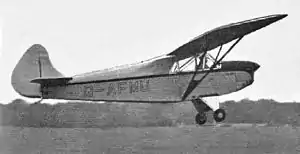Luton Major
The Luton L.A.5 Major was a 1930s British two-seat high-wing cabin monoplane. Following World War II, plans were made available to suit construction as a homebuilt aircraft.[1]
| L.A.5 Major | |
|---|---|
 | |
| Luton LA.5 Major, 1939 | |
| Role | Two-seat cabin monoplane |
| Manufacturer | Homebuilt |
| Designer | C.H. Latimer-Needham |
| First flight | 12 March 1939 |
History
The original L.A.5 Major was a two-seat light aircraft powered by a 62 hp Walter Mikron II engine. It was designed by C.H. Latimer-Needham, and built in 1939 by Luton Aircraft Limited at its Phoenix Works, Gerrards Cross, Buckinghamshire. The prototype (G-AFMU), designated L.A.5 Major, first flew on 12 March 1939. During 1943, the Phoenix Works burnt down, destroying the prototype, and causing the Luton Aircraft company to close.[2]
After World War II, Phoenix Aircraft Limited, formed by the designer C.H. Latimer-Needham and A.W.J.G. Ord-Hume, took over the design rights for the Luton Major. Latimer-Needham updated the design to make it more suitable for homebuilding, in which form it has become L.A.5A Major, with plans marketed by Falconar Avia of Edmonton, Alberta, Canada as the Cubmajor. An open cockpit version is marketed as the Majorette.[2][3][4]
Variants
Specifications (L.A.5)
Data from Jane's All the World's Aircraft 1958-59[5]
General characteristics
- Crew: 1
- Capacity: 1
- Length: 23 ft 9 in (7.24 m)
- Wingspan: 35 ft 2 in (10.72 m)
- Wing area: 163 sq ft (15.1 m2)
- Airfoil: RAF 48[6]
- Empty weight: 600 lb (272 kg)
- Gross weight: 1,030 lb (467 kg)
- Fuel capacity: 11 imp gal (13 US gal; 50 L)
- Powerplant: 1 × Walter Mikron II 4-cylinder air-cooled inverted in-line piston engine, 62 hp (46 kW)
- Propellers: 2-bladed
Performance
- Maximum speed: 105 mph (169 km/h, 91 kn)
- Cruise speed: 95 mph (153 km/h, 83 kn)
- Stall speed: 35 mph (56 km/h, 30 kn)
- Range: 300 mi (480 km, 260 nmi)
- Rate of climb: 700 ft/min (3.6 m/s)
Notes
- Aithur W. J. G. Ord-Hume (September 1965). "Major Revival". Sport Aviation.
- Jackson 1974, p. 261
- Air Trails: 76. Winter 1971.
{{cite journal}}: Missing or empty|title=(help) - Purdy, Don: AeroCrafter - Homebuilt Aircraft Sourcebook, page 154. BAI Communications. ISBN 0-9636409-4-1
- Bridgman, Leonard, ed. (1957). Jane's All the World's Aircraft 1958-59. London: Jane's All the World's Aircraft Publishing Co. Ltd. p. 96.
- Lednicer, David. "The Incomplete Guide to Airfoil Usage". m-selig.ae.illinois.edu. Retrieved 16 April 2019.
Bibliography
- Jackson, A.J. (1974). British Civil Aircraft since 1919 Volume 3. Putnam ISBN 0-370-10014-X